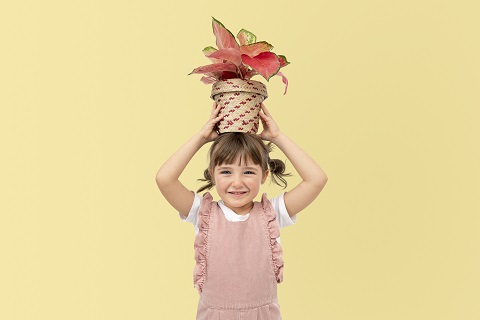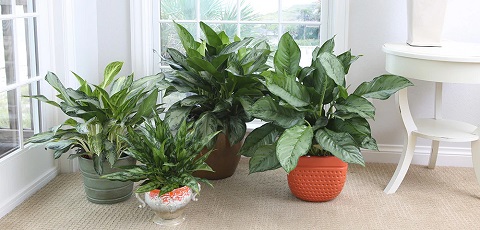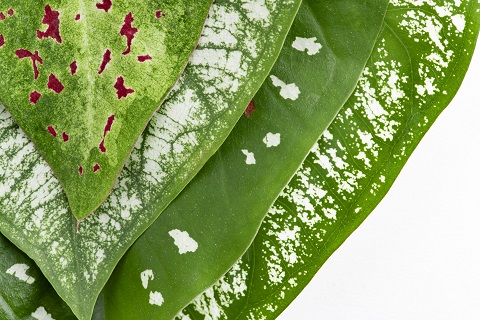
A Complete Guide to Chinese Evergreen Care

Do you want to know the secret to a lush Chinese Evergreen plant at home? Known as Aglaonema, this tropical evergreen comes in stunning varieties. Its leaves range from green, silver, and white to red, purple, and cream. These plants are perfect for making your indoor spaces pop. But, how do you keep them healthy for the long haul? Let’s look into the best ways to care for your Chinese Evergreen.
What makes the Chinese Evergreen so captivating? Is it the name Aglaonema, from Greek for "bright" and "thread," which points to the plant's stamens? Or is it because in Chinese feng shui, it’s thought to bring good luck and success? Whatever the case, the Chinese Evergreen indeed stands out. With the right care, there’s no doubt you can grow a beautiful one at home.
Key Takeaways
- The Chinese Evergreen (Aglaonema) is a tropical, evergreen perennial available in a variety of captivating cultivars.
- These plants have low-maintenance needs and can make excellent houseplants that thrive in a variety of indoor environments.
- The genus name "Aglaonema" originates from the Greek words for "bright" and "thread," referring to the plant's stamens.
- In Chinese feng shui, the Chinese Evergreen is believed to bring luck, prosperity, and success into the home.
- With the right lighting, watering, soil, and growing conditions, you can enjoy the beauty of this tropical plant for years to come.
Introduction to the Chinese Evergreen Plant
The Chinese evergreen, or Aglaonema, is from the Araceae family. It is a tropical plant popular for indoor decoration. Its name means "bright thread" in Greek, highlighting its unique stamen.
About the Aglaonema Genus
The Aglaonema genus offers many varieties with different leaf designs and colors. Chinese evergreens have large, glossy leaves in shades of green, silver, red, and more. They are mostly admired for their foliage over their flowers.
Common Names and Origins
The plant is also titled Philippine evergreen or Poison Dart Plant. It comes from tropical and subtropical Asia and New Guinea. Here, it enjoys the warm, moist air.
Toxicity Warning
Chinese evergreens have a toxin that can hurt pets like dogs and cats. If pets eat it, they might have mouth pain, swelling, and drool a lot. Pet owners should be careful where they place these plants to protect their furry friends.
Chinese Evergreen, Aglaonema, Plant Care
Chinese evergreens grow slowly and are great for indoors. They need little care and can survive all year. With the right care, Aglaonema will stay healthy without much effort.
| Care Aspect | Recommendation |
|---|---|
| Lighting | Bright, indirect light |
| Soil | Well-draining, slightly acidic potting mix |
| Watering | Keep soil moist but not waterlogged |
| Humidity | Maintain high humidity levels |
| Temperature | 65-80°F (18-27°C) |
| Fertilizing | Balanced liquid or slow-release fertilizer |
Chinese Evergreens are perfect for simple, beautiful indoor plants. They do well in different places inside. Just give them the right light, water, and soil, and they will bring freshness to your daily life.
Lighting Requirements for Chinese Evergreens

Chinese Evergreens (Aglaonema) are known for their ability to do well in low light. The darker green types can live in shadows, while those with splashes of color need a little more light. The more white or light green on the leaves, the brighter the spot they need. But, it still must be indirect light for the best growth.
Low Light Tolerance
Chinese Evergreens can survive in very dim places like north-facing rooms. They don't need much sunlight to stay green and healthy. They adjust how they grow to deal with the low light. This keeps them looking full and beautiful even in dark corners.
Variegated vs. Solid Green Varieties
Variegated Aglaonema stands out with its mix of green, white, and pink shades. These need a bit more light to keep their colors bright. Place them where they get indirect sunlight. But, never in direct sunlight because their leaves can get damaged.
Soil and Potting Needs
For your Chinese Evergreen to flourish, the right potting mix is key. A loose, well-drained, slightly acidic soil is best. If your soil holds too much water, add sand or perlite for better drainage. Mixing houseplant soil with compost and perlite creates a perfect blend.
Well-Draining Potting Mix
Chinese Evergreens love drier conditions, so avoid letting their soil get too wet. Keep the potting mix moist, but water less in winter.
Repotting Schedule
Your Chinese Evergreen should be repotted every two to three years. Do this in the spring if it looks crowded or rootbound. Spring is ideal because it supports the plant's natural growth time.
Watering Schedule for Aglaonema Plants
Keeping your Chinese Evergreen (Aglaonema) plants well-watered is key. These plants like being dry more than wet. It's best to water them every 5 to 10 days during growth periods. Water when the top of the soil feels dry to the touch. This keeps them moist but not swampy.
As it gets cooler, lessen how often you water. But, don't let your plant almost completely dry up. Check the soil often. If the top few inches are dry, it's time to water. You'll soon learn how much water your plant really needs.
Getting the water just right is important for your Chinese Evergreen plant. With the correct care, you'll see beautiful leaves year after year.
Temperature and Humidity Preferences

Being into indoor plants, I've found that Chinese evergreens are quite unique. These plants, known as Aglaonema, love warmth and moisture, but they don't do well in cold. They need an environment no colder than 55°F and feel best between 65°F and 80°F.
Ideal Temperature Range
Avoid placing Chinese evergreens near places that get cold easily, like vents or windows. Keeping the temperature around them steady is crucial for their health and happiness.
Increasing Humidity Levels
Chinese evergreens also need lots of humidity. You can up the moisture for them by putting them in steamy rooms like the kitchen or bathroom. Placing them on a pebble tray with some water underneath can also help. If your home stays dry, a small humidifier might be a good buy to keep them comfortable.
Fertilizing Your Chinese Evergreen
To help your Chinese Evergreen plants grow well, they need the right food. Even though these plants are tough, the right fertilizer makes their leaves lush and colorful.
Balanced Fertilizer for Houseplants
Use a slow-release or liquid fertilizer for your Chinese Evergreen. Find one with a balanced mix, like 10-10-10 or 20-20-20. These give your plant the main nutrients it needs to thrive.
Fertilizing Schedule
Feed your plant twice yearly, at the start and end of its active time. If the soil lacks nutrients, feed it every six weeks in spring and summer. But, too much food can harm it, causing burned leaves or slow growth.
Popular Aglaonema Cultivars
The Chinese Evergreen, or Aglaonema, has many beautiful varieties. The 'Frosher' has milky green leaves, while 'Maria' is dark green with silver stripes. There's one for every indoor space.
Frosher
'Frosher' has milky green leaves with cream and white patterning. This makes it a standout plant. It's truly unique.
Pseudobracteatum
The 'Pseudobracteatum' has unique leaves with green-gray splotches. It has white outlines on the veins, giving it depth.
White Rajah
The 'White Rajah' is bold and eye-catching. Its leaves are mostly white, making it stand out. It's a real showstopper.
Red Zircon
The 'Red Zircon' features green with pink in the center. This adds vibrant colors to the plant. It's a unique and beautiful variety.
Silver Bay
'Silver Bay' is captivating. It has green leaves with silver centers. This creates a beautiful effect on the plant.
Maria
The 'Maria' is great for low-light areas. It's dark green with silvery stripes. A good choice for darker indoors.
Pruning and Propagation
As the Chinese Evergreen plant grows, new stems and leaves appear mainly at the top. As time passes, lower leaves can fall off. This makes the plant look sparse at the bottom. To keep your plant looking full, it's important to prune it regularly.
Pruning Leggy Growth
Keep your Chinese Evergreen healthy by cutting off old or damaged leaves. Use a sharp tool to cut them away at the stem. If the stems grow too long and thin, cut them back just above where the 4th or 5th leaf grows. This helps your plant grow bushier and avoid being too tall and sparse.
Propagating by Stem Cuttings
It's easy to create new Chinese Evergreens from stem cuttings. Cut a healthy stem just below a leaf. Put the cutting in a glass of water, making sure the bottom leaves touch the water. Place it in a spot with indirect sunlight. In a few weeks, roots will start to grow. Then, move the cutting to a pot with good soil.
Propagating by Division
Another way to make more Chinese Evergreens is by dividing them. When you repot the plant, take it out of the pot. Gently pull apart the roots to make smaller plants. Plant these smaller plants in fresh soil and water them well. This method helps you grow more plants and give them to others.
Conclusion
Chinese evergreens are great for homes because they're easy to care for. They do well in different indoor places. With the right light, water, and soil, these tropical beauties will flourish for years indoors.
Following the plant care tips, I've grown a lovely Chinese Evergreen. It brightens up my space with its lush green leaves. This colorful and strong plant has truly enhanced my home’s atmosphere.
Even if you're new to plants like Aglaonema, you can still do this. Just follow these simple steps. You’ll have a beautiful Chinese Evergreen at home. It’s an easy way to enjoy nature’s splendor indoors.
FAQ
How often should I water Chinese evergreen?
Water every five to 10 days when it's growing. In winter, you can water less often. Don't let your plant get completely dry.
Do Chinese evergreens need sunlight?
Chinese evergreens don't need much light to thrive. Dark green types are fine with low light. But, those with variegated leaves need a bit more light. Avoid direct sunlight to prevent leaf burns.
Why are the tips of my aglaonema leaves turning brown?
Aglaonema leaves turning brown at tips could be from not enough water, little moisture in the air, or cold air. Keep the soil moist but not soggy. Add more humidity if you see browning.
What does an overwatered Chinese evergreen look like?
Overwatered Chinese evergreens might have yellow leaves or wilting. Their stems could become soft. And, they might face root rot. Let the soil dry slightly between waterings to avoid this.
Should I bottom water aglaonema?
Bottom watering Chinese evergreens is okay. Placing the pot in a tray of water lets the plant soak up water. This method lowers the risk of overwatering.
Do aglaonema like to be misted?
Yes, aglaonema likes being misted. It makes them feel at home in a humid space. Doing this regularly, especially in dry places, is good for them.
Where is the best place to put aglaonema?
Chinese evergreens do well in bright, but indirect light. They like the warmth, between 65 and 80°F. Rooms with high humidity, like bathrooms and kitchens, are great. Avoid spots with drafts.
How do you know if you are overwatering aglaonema?
If your aglaonema has yellow leaves, or soft stems, you might be overwatering. The soil may be staying wet too long. To fix this, let the soil dry slightly before watering again.
Credit: Image by rawpixel.com on Freepik



